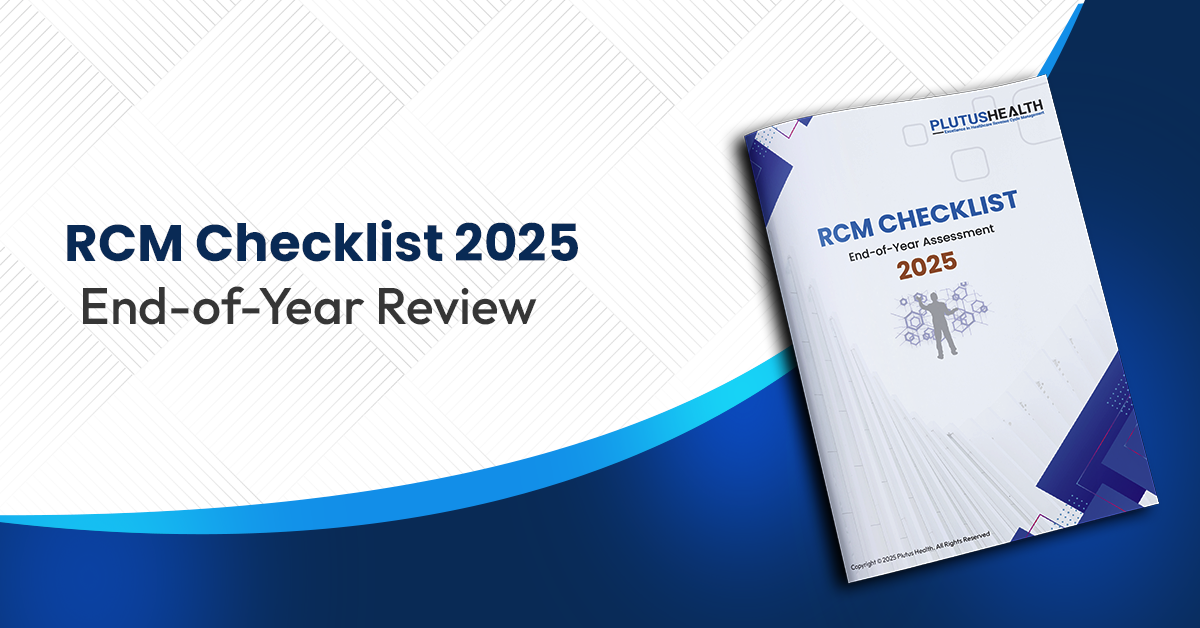The Best KPIs for Healthcare RCM, with Formulas, Benchmarks, and Cheat Sheet
Revenue cycle management (RCM) is the key to smooth operations and solid profits. But how do you track, report on, and optimize RCM? Enter key performance indicators, or KPIs.
Our seasoned revenue cycle management experts, with a collective experience of 50 years, have selected the 20 most influential KPIs for medical providers, encompassing the entire RCM process from patient scheduling to payment. The KPIs are listed according to the phase in billing, and each is accompanied by our internal benchmarks or the relevant industry standard.
We also have included the top 10 RCM KPIs from the Plutus Health Revenue Cycle Management Challenges Index 2023, where hundreds of healthcare organizations shared what they consider their most important RCM KPIs.
In this article, you’ll find:
- Top KPIs for each RCM step
- Free downloadable KPI cheat sheet
- Top 10 revenue cycle management KPIs
- RCM KPI dashboard template
The Top 20 Healthcare RCM KPIs, Divided by Step
The benefits of proper revenue cycle management cannot be overstated. But with over a hundred metrics to monitor the health of their RCM, it can be overwhelming. Knowing the right KPIs — those that matter most to the business — can save you time and effort, so you can focus on driving business outcomes.
Below, we outline the 20 best RCM KPIs to track, mapped to the relevant RCM step. The five phases of RCM are pre-service, service, billing, payment, and post-payment. Within these phases, there are 16 steps in revenue cycle management:
- Provider credentials verification
- Provider contract with insurance company verification
- Patient registration
- Appointment scheduling
- Patient eligibility and benefits verification
- Prior authorization
- Medical coding
- Charge entry and capture
- Claim submission
- Denial management
- Insurance follow-up
- Patient billing
- Patient collections
- Payment posting
- Reporting
- Financial evaluation
Broadly speaking, there are two categories of KPIs: leading, or outcome KPIs, and lagging, or input KPIs. While businesses are often most concerned with leading KPIs as a measure of outcomes, the lagging KPIs help the leaders to identify (and then focus on) areas of improvement, which in turn enables them to drive better leading metrics.
Appointment Scheduling KPIs
No-show or cancellation rate
The no-show or cancellation rate is the rate at which your patients cancel or don’t show up for appointments, typically measured per month.
The formula to calculate the no-show rate is:
A good benchmark is under 10%, according to our Plutus Health RCM experts.
Patient Eligibility and Benefits Verification KPIs
Exclusion Percentage
Exclusions are the patient accounts that failed the eligibility and benefits checks (that don’t have active insurance coverage), were unable to get the active insurance details, had coverage terminated claims, or had incomplete demographics while verifying the status.
The formula to calculate exclusion percentage is:
Exclusions are key to improving the clean claim percentage and the FPPR and the denial percentage metrics (see below.) Hold the claims for these items, and initiate the patient outreach and counseling to ensure claims payments.
Prior Authorization KPIs
Denials Due to Authorization Percentage
Prior authorization is a critical requirement when you have to render a service and ensure that claims are paid. The denials due to incorrect or no authorization percentage is a critical metric to ensure collections and reduce claim write-offs.
The formula to calculate the denial percentage due to authorization is:
This metric is calculated in terms of revenue. Some practices calculate it based on the number of claims, though that approach often underplays the issues.
Medical Coding KPIs
Discharged But Not Coded
The label discharged but not coded (DNC) refers to patient records that are ready for coding but not coded beyond the threshold of 48 hours.
The formula to calculate this KPI metric is:
The DNC benchmark is under 2 days. This metric ensures that the charts are coded in a timely manner and that you bill out the claims to insurances for faster payments.
Charge Entry and Capture KPIs
Unbilled Claims Percentage
Unbilled claims percentage refers to the percentage of claims that are not billed out to average daily claims volume. There are many reasons for the hold claims, but they should be either resolved promptly for faster payments and or denied for a timely filing limit.
The formula to calculate unbilled claims percentage is:
The best practice is to keep this figure under 2%. For calculation purposes, keep the threshold to any claims submitted within 48 hours.
Billing Lag
A billing lag refers to the average time from service date to claim billing date. The slower you bill, the slower you get paid.
The formula to calculate the billing lag is:
The average billing lag should be less than 48 hours. For hospitals, however, the billing lag may go up to 7 days.
Claim Submission KPIs
Payer Rejection Percentage
The payer rejection percentage is the percentage of claims rejected by the payers to the total number of claims submitted to the payer.
The formula to calculate the payer rejection percentage is:
The rejection rate benchmark is less than 2%. The claims can also be rejected from the clearinghouse, but the payer rejection percentage is typically the more meaningful KPI.
Clean Claim Ratio
The clean claim ratio is the percentage of claims that the insurance payer accepts without any rejections.
The industry benchmark is 98% and above. To calculate this quickly, take the inverse of the rejection percentage.
Denial Management KPIs
Initial Denial Percentage
The initial denial is the number of denials received from the overall claims submitted to the insurance, expressed as a percentage.
The formula to calculate the initial denial percentage is:
The industry benchmark is less than 5%, though it can be up to 8% in some settings.
You can calculate this KPI either based on the DOS (date of service) month or the transaction month. It’s easier to calculate it based on the transaction month.
Insurance Follow-Up KPIs
AR in the 90+ Days
This figure is calculated based on the date of service (DOS), and is easy to calculate.
The formula to calculate this KPI is:
The industry benchmark is less than 15% for physician practices and 20% for hospitals.
Calculate this KPI for both insurance and patient combined. However, you should also break down the figures between insurance and patient to identify the problem and address it accordingly. You can also break down this figure by financial class or the top payers to identify the problem specific to any financial class or the payer, if any.
Sometimes, this metric is obtained by the last billed date. This approach will only give the activity and efficiency of the billing and collections process, but will not tell you how long it takes for the business to resolve the AR from the time the patient was initially seen.
Insurance Write-Off Percentage
The insurance write-off percentage is the dollar value of the claims written off as an uncollectable that should have been collected.
The formula for insurance write-off percentage is:
The industry benchmark is 1.5%. Typically, you measure this KPI on a monthly, quarterly, and yearly basis. From a business management perspective, you should measure it on a yearly basis.
Patient Billing KPIs
Patient AR in 90+ days
This KPI shows you the percentage of patient accounts that are receivable over a 90-day period.
The formula for patient AR in 90+ days is:
The industry benchmark for this KPI is less than 20%.
Calculate this figure by taking the date when the balance moved to the patient's responsibility. This is often calculated by looking at the date of service when the PMS didn’t give the ready report based on balance movement date.
Patient Collections KPIs
First Pass Payment Ratio (FPPR)
The first pass payment ratio (FPPR) is the percentage of claims that are paid the first time without any intervention. It is expressed in terms of a percentage.
The formula to calculate the FPPR is:
The industry benchmark is 95%.
You can either calculate this KPI at the claim or dollar level. The dollar number would sometimes inflate by a percent or so (and is sometimes calculated by simply inverting the denial percentage, i.e., 1 – initial denial percentage). This is a very easy and quick way of getting the FPPR. The touches and interventions needed to work the Rejection are often not calculated in calculations.
Bad Debt Write-Off Percentage
A bad debt write-off is the dollar value of the claims written off as an uncollectable that should have been collected. This KPI is often expressed as a percentage.
The formula for the bad debt write-off percentage is:
Typically, you measure this KPI on a monthly, quarterly, and yearly basis. Business managers will likely look at this on a yearly basis.
Payment Posting KPIs
Credit Balance
The credit balance is the overpayment received by the practice. It is calculated at the date the credit is created, as the value above a certain aging bucket, typically 30 days.
The formula to calculate the credit balance is:
This KPI is extremely important in managing compliance. It’s best to keep the credit balance minimal over 30 days. Again, it’s best to further break down this figure by insurance and patient — doing so will help in prioritization and resolution.
Unapplied Percentage
The unapplied percentage is the money that is posted into the temporary account (often called the unapplied, unallocated, or suspense account). It is critical to resolve the unapplied amount in a timely manner so that it doesn’t affect the AR collections and resolution.
The formula to calculate the unapplied percentage is:
The industry benchmark for this KPI is 10%.
Any unapplied amount from the patients that is not applied to the patient accounts will affect the patient statements and ability to collect from the patients.
Reporting KPIs
Average Revenue Per Visit (ARPV)
Average revenue per visit (ARPV) is a measure of how much money the practice is making from every patient visit. Typically, this is calculated on a monthly basis.
The formula to calculate ARPV is:
There is no single benchmark number for the ARPV, as it depends on the healthcare specialty and contract rate.
You should include both insurance and patient payments and collections for the calculation, and calculate this on the date of service on a monthly basis. This number may vary, depending on how quickly the practice typically collects full payment.
Some practices calculate ARPV per patient. Either is workable, but the per-visit calculation removes the inconsistencies in the number of claims per patient per month.
Net Collections Ratio
The net collections ratio (NRC) is expressed as a percentage. The NCR percentage shows how much you collected vs. how much you should have collected. This is the true reflection of business effectiveness.
The formula to calculate NCR is:
The industry benchmark is 98%, though the best-run practices maintain a 99%.
Note that it’s very important to differentiate the contractual adjustments from the write-offs. Contractual adjustments refer to the adjustment of the charges that the practice is entitled to get from the payers or the patients.
You can calculate the NCR percentage based on the date of service basis or the transaction date basis. The date of service basis will give you the most accurate numbers, but it requires a few months’ worth of data. The transaction date basis, on the other hand, can be calculated month-to-month basis, but it is more accurate to look at it as an average over a longer period of time, as any single month will not give the true picture due to inconsistencies in both charges and payments for different months.
Financial Evaluation KPIs
Use the KPIs in this section to evaluate the overall financial performance of your practice. For more best practices on financial health, learn how to effectively manage AR in healthcare RCM.
Cost to Collect
The cost to collect is the overall cost incurred to collect the money. To calculate this KPI, you should include all of the direct, indirect, and overhead costs, general and administrative costs, and perhaps sales and marketing costs as well.
The formula to calculate the cost to collect is:
The industry benchmark ranges from 3% to 8% and varies based on the size of the practice, specialty, average revenue per visit, and other factors.
Days in AR (DAR) or Days of Sales Outstanding (DSO)
DAR (days in AR) or DSO (days of sales outstanding) is a measure of how quickly the business collects payments. It is defined as how many days’ worth of charges are in the AR or how many days’ worth of charges are outstanding.
The formula to calculate DAR is:
The benchmark is less than 30 days, though the best-run practices maintain around 25 days.
You can also calculate this KPI at the insurance or patient level to further identify the source of the issue (and address it accordingly). But, it is advised to calculate it as combined.
This quick cheat sheet lists all 20 top RCM KPIs described above, alongside the formula and benchmark for each. Use this document as a reference to quickly identify and calculate the relevant KPIs to your practice, and check your metrics against industry standards.
Top 10 Most Popular Healthcare RCM KPIs
While all 20 KPIs above are important to different steps in revenue lifecycle management, our experts provided the top 10 to know. This graphic shows the most critical RCM KPIs to continually calculate and report on, so you can stay on track toward your business goals.
Download an RCM Dashboard Template
Use this RCM dashboard template to fill in top KPIs as you calculate them for your practice. The template comes pre-loaded with several common RCM KPIs, sorted by RCM phase and step, as well as benchmarks for each KPI, as applicable. Simply fill in the dashboard with data from your practice, check your figures against industry benchmarks, and track your success over time.
How Outsourcing RCM Can Improve Your KPIs
Many healthcare organizations find a huge return on investment when they outsource their RCM to an expert company. Companies that focus on RCM help healthcare organizations quickly understand how they can and should improve their billing and revenue processes, and help organizations understand their insurance denials and how to quickly manage them.
Increasingly, healthcare organizations use artificial intelligence to help with RCM. Several companies use advanced AI to help organizations find claim errors before the organizations even submit the claims, which saves time and money. The integration of AI in RCM is an evolving and expanding domain. It is advisable not to engage with RCM service providers that do not incorporate AI in their operations.
Efficient Revenue Cycle Management Outsourcing
Plutus Health helps our clients significantly improve their RCM processes and boost their financial performance. Plutus uses artificial intelligence, machine learning, and robotic process automation to create custom solutions that easily integrate with your existing systems.
That all means quick improvements in your processes, revenue, and profits. To better understand your current processes and how we can help you improve them, schedule a free RCM assessment today.



















































